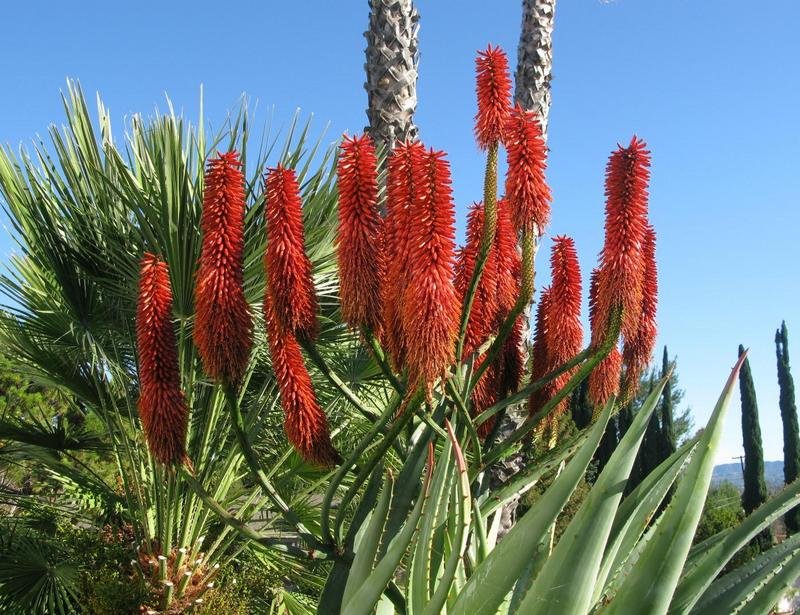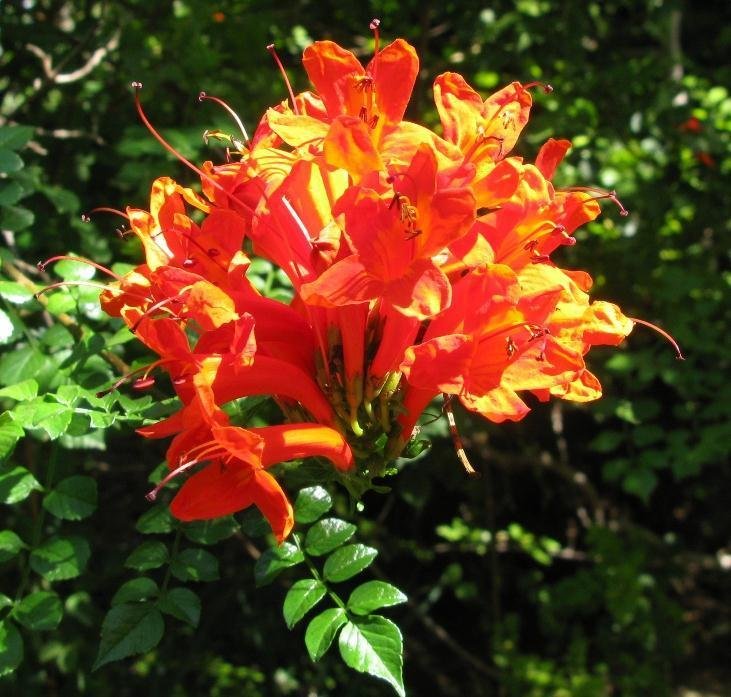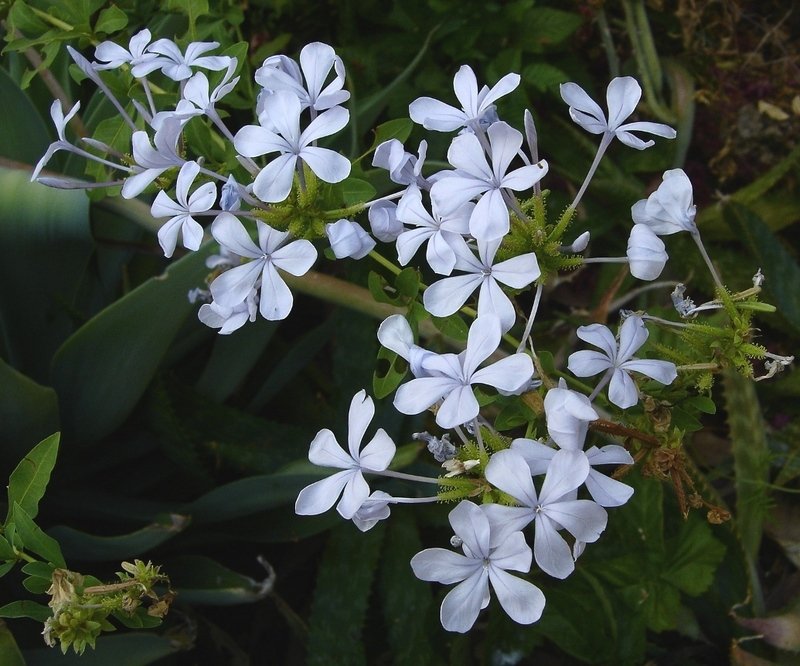





The foreign landscaping plants used in landscaping in the United States are native plants somewhere. Anywhere plants are native, the local people have developed uses for many of them. For much of human history, a person was limited to what himself, his family, or his village could find or produce and that meant a hefty reliance on local plants. Some of these useful plants are also very attractive and were taken to the western world by plant collectors in the 19th and 20th centuries. Therefore, your landscaping and collector plants are more than curiousities. They may have been and may still be a matter of life and death, or at least a way to make life easier in a subsistance lifestyle in a harsh climate.
This article deals with the traditional uses of southern African plants that are used virtually solely as decorative items in the United States. These are used both by native Africans and settlers of European ancestry. Some are still being used in rural areas and some are even grown commercially. This is not a dead or dying academic subject. Research is always being done on ways to use African plants in modern industries like cosmetics and pharmaceuticals.
Please note that the information given here is to be considered anecdotal. Mention of any remedy here does not imply that it is effective or safe. Do not consume for food or medicine any of these plants without first checking multiple sources to verify their safe use. Some of these plants can be highly poisonous if consumed in the wrong doses or without the correct preparation. If you are pregnant, be doubly careful consuming or applying these plants topically, for some may cause untimely uterine contractions.
Agapanthus africanus - Ubani (Zulu), Blue lily (South African English), Leta-la-phofu (Sotho), Bloulelie (Afrikaans), Lily of the Nile (American English) - A preparation of the roots is taken in the sixth or seventh month of pregnancy. It is mildly laxative, a uterotonic, and may assist the functioning of the kidneys. Water in which the plant is growing is taken twice a day from the fifth month of pregnancy to ensure a healthy baby. A strong decoction of the rhizome is taken to induce labor, augment contractions, and to expel the placenta. An infusion of the root is used as an emetic for coughs and chest and heart conditions.
Aloe arborescens - Krantz aloe (South African English), Inkalane (Zulu), Kransaalwyn (Afrikaans), Tree aloe (American English) - Gel from the leaves is used to treat burns and wounds.
Aloe ferox - Bitter aloe (South African English), Umhlaba (Xhosa, Zulu, Sotho), Bitteraalwyn (Afrikaans) - The thick, bitter, yellow juice from the cut leaf surface is boiled to concentrate it and the resulting dark brown substance is called Cape aloes. It is taken internally as a laxative. Powdered Cape aloes is mixed with petroleum jelly and applied to herpes and shingles outbreaks. Cape aloes was once used as a skin lightener. The fresh bitter liquid is applied to the conjunctiva for conjunctivitis and sinusitis. The translucent leaf gel has a long history of being consumed as a food and as a general tonic. A mixture of aloe ash and soap was used by Swazi men as a hair bleach. The ash of the leaves of various aloe species is added to stored grain to repel weevils.

Aloe ferox
Aloe zebrina - Kgopalmabalamantsi (Tswana) - Powdered stems and leaf bases are taken twice a day after delivery in order to cleanse the system. The yellow roots are used to dye wool and basketry material. This species produces a golden yellow color. Other species of aloes are used to produce other colors.
Aponogeton distachyus - Waterbloometjies (Afrikaans), Cape pondweed (English) - This water plant is grown for its fragrant flowers and floating foliage in American water gardens, but it is grown for food on a small scale in South Africa. The flower heads are eaten and the most popular usage is in a traditional bredie or stew made with onions, potatoes, and lamb. The flowers can also be steamed and eaten on their own. They are reported to taste like asparagus. Canned or bagged waterblommetjies can be purchased in South African supermarkets. The starchy rhizomes were eaten by the Khoi and San in earlier times. Juice from fresh stems or a poultice of fresh leaves is used to dress burns and abrasions.
Carissa macrocarpa - Amathungulu (Zulu), Big num-num (African English), Natal plum (American English) - This shrub is grown in the United States mainly for its evergreen foliage and fragrant flowers but the fruit is edible and can be used fresh or in pies and jelly. Wild fruits of many kinds are beloved by African children and are likely an important source of nutrition.
Carpobrotus edulis - Sour fig (South African English), Suurvy (Afrikaans), Hottentot fig (American English) - This succulent plant has been used as a groundcover and has naturalized along the Pacific Coast from Oregon to Baja. In its native range, it has many uses. The fruits are ripe after they turn brown and the soft insides are eaten as-is or made into jelly. Juice from the leaves is gargled for throat infections and is reported to be effective for diarrhea and giardiasis. Juice from the leaves is also used to treat diaper rash.
Clivia miniata - Umayime (Zulu), Orange lily (South African English), Boslelie (Afrikaans) - Preparations of the leaves and rhizomes are used to initiate labor and facilitate delivery. Research has shown that leaf extracts have uterotonic effects.
Dioscorea sylvatica - Wild yam (English) - Root decoctions are taken for chest conditions, as blood purifiers, and a a ritual emetic. Crushed tubers are applied to swellings and rashes. Diosgenin derived from the tuber was used to produce oral contraceptives in the 1950s.
Erythrina caffra - Coastal coral tree (South African English) and Erythrina lysistemon - Common coral tree (South African English), Umsinsi (Zulu), Nsisimbane (Tsonga), Muvale (Tswana), Gewone koraalboom (Afrikaans) - The bark of these trees is used to treat sores, wounds, abscesses, and arthritis. Powdered burned bark is applied to open wounds. Infusions of the leaves are taken as ear drops for earaches.

Cape honeysuckle
Euphorbia ingens - Common tree euphorbia (South African English), Naboom (Afrikaans), Candelabra tree (American English) - Branches are thrown into the water to poison fish. The dead or paralyzed fish come to the surface of the water and can be gathered for food. The wood is used for boats, planks, and doors.
Leonotis leonurus - Wilde dagga (Afrikaans), Lion's tail (American English) - Infusions and decoctions of the leaves are used for colds, flu, coughs, bronchitis, asthma, high blood pressure, and headaches. In earlier times, the plant was smoked to produce a mild, sedated intoxication. The leaves stop bleeding and have been used by women for menstrual problems. They have also be used to induce abortion.
Leucadendron pubescens - Knokkers (Africaans), Gray Conebush (English) - This shrub from the Protea Family has separate male and female plants. The female plants produce cones that bear numerous edible seeds that are reported to be delicious.
Mesambryanthemum crystallinum - Ice plant (English) - Juice from the leaves was used to remove hair from hides to prepare them for tanning.
Nymphaea caerulea - Blue water lily (English), Tswii, Modidima (Tswana), Blouwaterlelie (Afrikaans) - The tubers of this plant are considered a staple food in the Okavango and parts of Zimbabwe. The tubers are peeled and though they can be eaten raw, they are usually cooked. The flower heads and seeds are also edible. The powdered root has been used to treat asthma.
Oxalis pes-caprae - Sorrel (South African English), Suring (Afrikaans), Bermuda buttercup (American English) - This plant has become invasive in the United States but in South Africa, the sour leaves are an essential flavoring ingredient in waterblommetjie stew. Children often eat the leaves and roots raw and the leaves of this and other Oxalis species are used as pot herbs all over southern Africa.
Phoenix reclinata - Wild date palm (African English), Isundu (Xhosa, Zulu), Ankindu (Thonga), Wildedadel (Afrikaans), Senegal date palm (American English) - The profusion of common names would suggest that this is a very useful plant, and it is. The fruit is edible and nutritious though it is mostly seed. The palm hearts are harvested as food. The stems are used to make hand brooms. The leaves are used to make baskets and mats. The leaf midribs are used in hut construction and to make fish kraals. The sap is tapped to make palm wine.

Cape plumbago
Plumbago auriculata - Umabophe (Xhosa), Utshilitshili (Zulu), Syselbos (Afrikaans), Cape plumbago (American English) - Powder of the leaves and roots is snuffed up the nose to treat headaches.
Portulacaria afra - Spekboom (Afrikaans), Elephant food (American English) - This plant is more than elephant food, it is people food, too. The leaves are eaten raw.
Strelitzia nicolai - Giant bird of paradise (American English), Natal wild banana (South African English) - This tree-like plant produces lush tropical-looking foliage and white flowers that are very similar the orange flowers of the more common bird of paradise (Strelitzia reginae). Although the plant may be called a wild banana, it is not a true banana (Musa species) and the fruit is full of seeds. The mature black seeds have bright orange, hairy arils. The seeds are ground into meal, mixed with water, and shaped into a patty. The arils are pressed into the surface of the patty. This is then baked over coals. The resulting cake is said to be filling but bland.
Tecomaria capensis - Cape honeysuckle (English) - The powdered bark is taken to relieve pain and promote sleep. Powdered bark is rubbed around the teeth for bleeding gums.
Tulbaghia violacea - Wild garlic (South African English), Society garlic (American English) - The rhizomes and leaves are used to treat fever, asthma, and constipation. Leaves are taken for esophageal cancer. The species is planted as a snake repellent.
Zantedeschia aethiopica - Arum lily (South African English), Inyabiba (Xhosa), Calla lily (American English) - Leaves are heated and applied to wounds, boils, and sores. The leaves are used to dye wool various shades of yellow.
African landscaping plants are more than something pretty or interesting to see. They have been important ingredients to life. Many are still being used to provide nourishment, comfort, health, and income for resourceful people.
Reference: Van Wyk, Ben-Eric and Gericke, Nigel, People's Plants, Briza Publications, 2000
Copyright © www.100flowers.win Botanic Garden All Rights Reserved